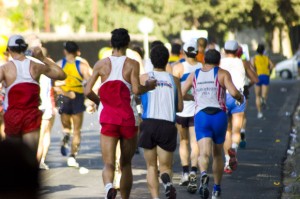
Exercising in hot climates increases your core body temperature.
If you are an avid sportsperson, you should be aware of the effects of exercising in extreme climates that your body may not be used to.
You also need to know what you can do to avoid putting your health at risk.
Hot climates
Exercising in hot climates increases your core body temperature, which puts your body under additional strain. To cool yourself down, your body sends more blood to the skin’s surface (which is why you turn bright red). However, this response lowers the flow of blood to your muscles, which means your heart has to work harder in order to pump oxygen around the body.
Humid climates also stop your sweat from evaporating as quickly from your skin, meaning the body’s natural cooling function is not as effective and adds to your increasing body temperature.
If you are not fully acclimatised to this level of heat, your natural cooling systems will not be sufficient and it could lead to a heat-related illness. Examples include: heat cramps, exhaustion and in some cases heat stroke. These conditions can cause: nausea, vomiting, headaches, fatigue, confusion, irritability, heart rhythm issues, dizziness and visual problems. Without immediate medical attention you can suffer brain damage, organ failure and even death.
Key things to remember:
- Allow your body to acclimatise, take it easy to begin with and build up your routine slowly over 2 weeks to allow your body to get used to the change in temperature.
- Drink plenty of water before, during and after exercise.
- Wear appropriate clothing, there are a number of companies that produce exercise clothing specifically to help you stay cool in warm environments.
- Change the time you play/exercise to avoid the extreme temperatures of midday. It is better to exercise early morning/late evening.
- Check forecasts for extreme heat warnings.
- Wear sun protection, take frequent breaks and refrain from alcohol the day before.
Cold climates

Keeping your body hydrated when exercising in cold climates, is just as important as in hot climates.
The main risks of exercising in cold weather are frostbite and hypothermia. Frostbite occurs as a result of the freezing of your tissue. Hypothermia is the decrease in body temperature which leads to impaired motor and cerebral functions. Both conditions can be fatal if left unchecked.
The main causes of these climate related illnesses occur due to inappropriate clothing. Layers are important to prevent hypothermia, creating insulation to keep your body temperature stable. The base layer should be a material that removes sweat from the skin and dries quickly. This is important because wet clothing loses its insulation quickly and increases the risk of hypothermia. Frostbite can affect your hands, feet, cheeks, nose and ears as well which means that you should keep these body parts covered in extremely low temperatures.
Key things to remember:
- Wear appropriate clothing. You can find specialist sports shops that sell sports gear for cold climates.
- Be aware of wind chill as temperature readings do not always incorporate this factor and it can drastically drop the temperature.
- Keep yourself hydrated. Drinking enough water is just as important in cold climates, as it is in hot. It is often more difficult to visualise how much water you are losing while wearing layers, so you need to pay extra attention to your water consumption.
- Pack high energy bars to keep your body refueled while exercising. You use more calories in colder temperatures because your body is working harder to maintain your body temperature.
It is important to remember that your body takes time to become accustomed to new environments and over straining yourself in extremely dangerous. Wear the appropriate attire, keep an eye on the temperature, take it slow at first, and remember to stay hydrated.
